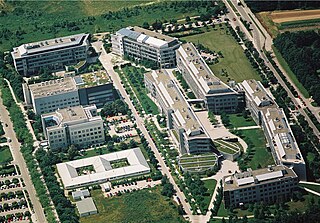
Adolf Friedrich Johann Butenandt was a German biochemist. He was awarded the Nobel Prize in Chemistry in 1939 for his "work on sex hormones." He initially rejected the award in accordance with government policy, but accepted it in 1949 after World War II. He was President of the Max Planck Society from 1960 to 1972. He was also the first, in 1959, to discover the structure of the sex pheromone of silkworms, which he named bombykol.

Richard Johann Kuhn was an Austrian-German biochemist who was awarded the Nobel Prize in Chemistry in 1938 "for his work on carotenoids and vitamins".

Wilhelm Traube was a German chemist.

François Diederich was a Luxembourgian chemist specializing in organic chemistry.

Wilhelm Keim was a German chemist and professor of chemistry at the Technical Chemistry and former director of the Institute for Technical and Petrol Chemistry at RWTH Aachen in Germany.

The Liebig Medal was established by the Association of German Chemists in 1903 to celebrate the centenary of Justus von Liebig. Since 1946 it has been awarded by the Society of German Chemists.

Dr. Hans Adolf Breuer was a German physicist and author of 23 mainly scientific books.
Heinz A. Staab was a German chemist. From 1990 to 1996 he was Präsident der Max Planck Society.

Arginylglycylaspartic acid (RGD) is the most common peptide motif responsible for cell adhesion to the extracellular matrix (ECM), found in species ranging from Drosophila to humans. Cell adhesion proteins called integrins recognize and bind to this sequence, which is found within many matrix proteins, including fibronectin, fibrinogen, vitronectin, osteopontin, and several other adhesive extracellular matrix proteins. The discovery of RGD and elucidation of how RGD binds to integrins has led to the development of a number of drugs and diagnostics, while the peptide itself is used ubiquitously in bioengineering. Depending on the application and the integrin targeted, RGD can be chemically modified or replaced by a similar peptide which promotes cell adhesion.
Heino Finkelmann is a retired German chemist in the area of liquid-crystalline elastomers.

The Center for Integrated Protein Science Munich (CIPSM) is a cluster of excellence in sciences located in Munich. It is an association of research groups of the Ludwig Maximilian University of Munich, the Technical University of Munich, the Helmholtz Center Munich, and the Max Planck Institutes of biochemistry and neurobiology in Martinsried. Research at the center expands from isolated proteins up to proteins in living organisms applying methods of biophysics, biochemistry, medicine, and biology.

The Zeitschrift für Naturforschung B: A Journal of Chemical Sciences is a monthly peer-reviewed scientific journal. The journal publishes "fundamental studies in all areas of inorganic chemistry, organic chemistry, and analytical chemistry" in both English and German. Articles in German are required to be accompanied by an English-language title and abstract. According to the Journal Citation Reports, the journal has a 2014 impact factor of 0.744. The editors-in-chief are Gerhard Müller and Annette Schier.

Martin Stratmann is a German electrochemist and materials scientist. He is one of the directors at the Max-Planck-Institut für Eisenforschung in Düsseldorf since 2000, and heads its department of Interface Chemistry and Surface Engineering.

Margot Becke-Goehring was a Professor of Inorganic Chemistry at the University of Heidelberg and she was the first female rector of a university in West Germany - the Heidelberg University. She was also the director of the Gmelin Institute of Inorganic Chemistry of the Max Planck Society that edited the Gmelins Handbuch der anorganischen Chemie. She studied Chemistry in Halle (Saale) and Munich, and she finished her doctorate and habilitation at the University of Halle. For her research on the chemistry of main-group elements, she was awarded Alfred Stock Memorial Prize. One of her most notable contributions to inorganic chemistry was her work on the synthesis and structure of poly(sulfur nitride), which was later discovered to be the first non-metallic superconductor. For her success in editing the Gmelins Handbuch der anorganischen Chemie, she received the Gmelin-Beilstein memorial coin.

Manfred Theodor Reetz is a German chemist and professor of organic chemistry, who served as director of the Max Planck Institute for Coal Research from 1991 until 2011. His research focuses on directed evolution, enzymes in organic chemistry, and stereoselective biocatalysis.
Wilhelm Karl Klemm was an inorganic and physical chemist. Klemm did extensive work on intermetallic compounds, rare earth metals, transition elements and compounds involving oxygen and fluorine. He and Heinrich Bommer were the first to isolate elemental erbium (1934) and ytterbium (1936). Klemm refined Eduard Zintl's ideas about the structure of intermetallic compounds and their connections to develop the Zintl-Klemm concept.
Arndt Simon is a German inorganic chemist. He was a director at the Max Planck Institute for Solid State Research in Stuttgart.

Luis Moroder was an Italian peptide chemist, who pioneered research on the interactions between peptide hormones and cell membrane-bound hormone receptors. He later expanded this research to other biological systems of medical relevance such as protein inhibitors, collagens, and synthetic proteins. A hallmark of his research is interdisciplinarity as reflected in his use and development of methods in organic chemistry, biophysics and molecular biology. He was a co-editor of the five-volume Houben-Weyl, Methods of Organic Chemistry, Synthesis of Peptides and Peptidomimetics. From 2008 he was the editor-in-chief of the Journal of Peptide Science, the official journal of the European Peptide Society.

Benjamin List is a German chemist who is one of the directors of the Max Planck Institute for Coal Research and professor of organic chemistry at the University of Cologne. He co-developed organocatalysis, a method of accelerating chemical reactions and making them more efficient. He shared the 2021 Nobel Prize in Chemistry with David MacMillan "for the development of asymmetric organocatalysis".
Rainer Haag is a German chemist and Chair Professor of Organic and Macromolecular Chemistry at the Free University of Berlin. He conducts research together with his working group on preventing aggressive pathogens and viruses from entering the body's cells using nanotechnology. He heads a team composed of biochemists, physicians, biologists and physicists.















